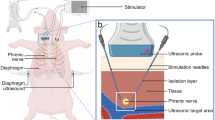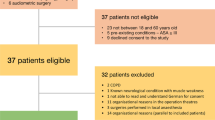Abstract
Introduction
Case reports, case series and case control studies have looked at the use of phrenic nerve stimulators in the setting of high spinal cord injuries and central hypoventilation syndromes dating back to the 1980s. We evaluated the evidence related to this topic by performing a systematic review of the published literature.
Methods
Search terms “phrenic nerve stimulation,” “phrenic nerve and spinal cord injury,” and “phrenic nerve and central hypoventilation” were entered into standard search engines in a systematic fashion. Articles were reviewed by two study authors and graded independently for class of evidence according to published guidelines. The published evidence was reviewed, and the overall body of evidence was evaluated using the grading of recommendations, assesment, development and evaluations (GRADE) criteria Balshem et al. (J Clin Epidemiol 64:401–406, 2011).
Results
Our initial search yielded 420 articles. There were no class I, II, or III studies. There were 18 relevant class IV articles. There were no discrepancies among article ratings (i.e., kappa = 1). A meta-analysis could not be performed due to the low quality of the available evidence. The overall quality of the body of evidence was evaluated using GRADE criteria and fell within the “very poor” category.
Conclusion
The quality of the published literature for phrenic nerve stimulation is poor. Our review of the literature suggests that phrenic nerve stimulation is a safe and effective option for decreasing ventilator dependence in high spinal cord injuries and central hypoventilation; however, we are left with critical questions that provide crucial directions for future studies.

Similar content being viewed by others
References
Balshem H, Helfand M, Schünemann HJ, Oxman AD, Kunz R, Brozek J, Vist GE, Falck-Ytter Y, Meerpohl J, Norris S, Guyatt GH (2011) GRADE guidelines: 3. Rating the quality of evidence. J Clin Epidemiol 64(4):401–406. doi:10.1016/j.jclinepi.2010.07.015
(2012) Spinal cord injury facts and figures at a glance. J Spinal Cord Med 35(4):197–8. doi:10.1179/1079026812Z.00000000063
Brown R, DiMarco AF, Hoit JD, Garshick E (2006) Respiratory dysfunction and management in spinal cord injury. Respir Care 51(8):853–868 discussion 869–70.
Weese-Mayer DE, Marazita ML, Rand CM, Berry-Kravis EM. Congenital Central Hypoventilation Syndrome. 2004 Jan 28 [updated 2014 Jan 30]. In: Pagon RA, Adam MP, Ardinger HH, Wallace SE, Amemiya a, Bean LJH, bird TD, Fong CT, Mefford HC, smith RJH, Stephens K, editors. GeneReviews® [internet]. Seattle (WA): University of Washington, Seattle; 1993-2015. Available from http://www.ncbi.nlm.nih.gov/books/NBK1427/PubMed
Stanley E, Broderick J, Synnott K, McCarthy J, Smith E, Reid V, Colreavy F, Carton E (2014) Successful weaning from mechanical ventilation using phrenic nerve stimulation. Ir J Med Sci 183(1):149–150. doi:10.1007/s11845-013-0989-8
Abdunnur SV, Kim DH (2015) Phrenic nerve stimulation: technology and clinical applications. Prog Neurol Surg 29:64–75. doi:10.1159/000434657
Broggi G, Franzini A, Borroni V (1980) Phrenic nerve pacing in reversible cervical cord lesion: a case report. Acta Neurochir 51(3–4):273–278
Fritz U, Braun U, Friedrich M, Bockermann V, Markakis E (1995) Implantation of aphrenic stimulator in central respiratory paralysis. Anaesthesist 44(12):880–883
Ordronneau J, Despins P, Keravel Y, Chailleux E, Guiheneuc P, Chollet S (1989) Phrenic stimulation in C1-C2 tetraplegia. Apropos of a case. Rev Mal Respir 6(5):469–471
Sitthinamsuwan B, Nunta-aree S (2009) Phrenic nerve stimulation for diaphragmatic pacing in a patient with high cervical spinal cord injury. J Med Assoc Thail 92(12):1691–1695
Son BC, Kim DR, Kim IS, Hong JT (2013) Phrenic nerve stimulation for diaphragm pacing in a quadriplegic patient. J Korean Neurosurg Soc 54(4):359–362. doi:10.3340/jkns.2013.54.4.359
Taira T, Takeda N, Itoh K, Oikawa A, Hori T (2003) Phrenic nerve stimulation for diaphragm pacing with a spinal cord stimulator: technical note. Surg Neurol 59(2):128–132 discussion 132
Fodstad H (1987) The Swedish experience in phrenic nerve stimulation. Pacing Clin Electrophysiol 10(1 Pt 2):246–251
Mayr W, Bijak M, Girsch W, Holle J, Lanmüller H, Thoma H, Zrunek M (1993) Multichannel stimulation of phrenic nerves by epineural electrodes. Clinical experience and future developments. ASAIO J 39(3):M729–M735
Nakajima K, Sharkey PC (1990) Electrophrenic respiration in patients with craniocervical trauma. Stereotact Funct Neurosurg 54-55:233–236
Sharkey PC, Halter JA, Nakajima K (1989) Electrophrenic respiration in patients with high quadriplegia. Neurosurgery 24(4):529–535
Oakes DD, Wilmot CB, Halverson D, Hamilton RD (1980) Neurogenic respiratory failure: a 5-year experience using implantable phrenic nerve stimulators. Ann Thorac Surg 30(2):118–121
Baer GA, Talonen PP, Shneerson JM, Markkula H, Exner G, Wells FC (1990) Phrenic nerve stimulation for central ventilatory failure with bipolar and four-pole electrode systems. Pacing Clin Electrophysiol 13(8):1061–1072
Romero FJ, Gambarrutta C, Garcia-Forcada A, Marín MA, Diaz de la Lastra E, Paz F, Fernandez-dorado MT, Mazaira J (2012) Long-term failure due to high cervical spinal cord injury. Spinal Cord 50(12):895–898. doi:10.1038/sc.2012.74
Le Pimpec-Barthes F, Gonzalez-Bermejo J, Hubsch JP, Duguet A, Morélot-Panzini C, Riquet M, Similowski T (2011) Intrathoracic phrenic pacing: a 10-year experience in France. J Thorac Cardiovasc Surg 142(2):378–383. doi:10.1016/j.jtcvs.2011.04.033
Khong P, Lazzaro A, Mobbs R (2010) Phrenic nerve stimulation: the Australian experience. J Clin Neurosci 17(2):205–208. doi:10.1016/j.jocn.2009.06.012
Giglio AM, Rovella C, Botindari E, Alba M (2002) The phrenic nerve stimulator, a valid ventilatory support in the management of quadriplegic patients receiving home health care services. A case report. Minerva Anestesiol 68(6):567–571
Hirschfeld S, Exner G, Luukkaala T, Baer GA (2008) Mechanical ventilation or phrenic nerve stimulation for treatment of spinal cord injury-induced respiratory insufficiency. Spinal Cord 46(11):738–742. doi:10.1038/sc.2008.43
Author information
Authors and Affiliations
Corresponding author
Ethics declarations
Conflict of interest
The authors declare no conflict of interest.
Rights and permissions
About this article
Cite this article
Sieg, E.P., Payne, R.A., Hazard, S. et al. Evaluating the evidence: is phrenic nerve stimulation a safe and effective tool for decreasing ventilator dependence in patients with high cervical spinal cord injuries and central hypoventilation?. Childs Nerv Syst 32, 1033–1038 (2016). https://doi.org/10.1007/s00381-016-3086-2
Received:
Accepted:
Published:
Issue Date:
DOI: https://doi.org/10.1007/s00381-016-3086-2




